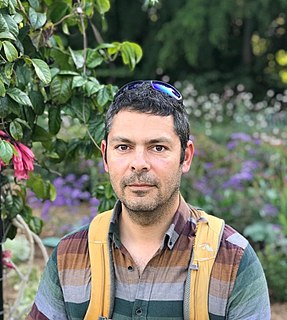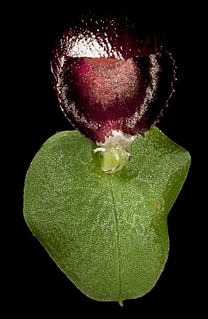
Corybas, commonly known as helmet orchids, is a genus of about 120 species of plants in the orchid family, Orchidaceae. Helmet orchids are small, perennial, deciduous herbs and are nearly always terrestrial. They have a single leaf at their base and a single flower on a short stalk, the flower dominated by its large dorsal sepal and labellum. Species of Corybas are found in Australia, New Zealand, New Guinea, Southeast Asia, the Himalayas, southern China, many Pacific islands and a few sub-Antarctic islands.

Alastair S. Robinson is a taxonomist and field botanist specialising in the carnivorous plant genus Nepenthes, for which he is regarded as a world authority. He is currently a manager at the National Herbarium of Victoria, Royal Botanic Gardens Melbourne, where he oversees identification botany services, the Library and Artwork components of the State Botanical Collection, and the botanical journal Muelleria, a peer-reviewed scientific journal on botany published by the Royal Botanic Gardens Victoria, for which he is Editor in Chief.
Nematoceras is a genus of orchids, sometimes known as spider orchids, helmet orchids or spidery helmet-orchids, found mainly in New Zealand and its subantarctic islands, with two species on Australia's Macquarie Island. The genus was originally described in 1853 by Joseph Dalton Hooker who published his description in The botany of the Antarctic voyage of H.M. discovery ships Erebus and Terror. II. Flora Novae-Zelandiae. In 2002 David Jones, Mark Clements and Brian Molloy transferred some species of Corybas to Nematoceras but the move has not been accepted by the World Checklist of Selected Plant Families at Royal Botanic Gardens, Kew.
Corybas sulcatus, also known as the grooved helmet-orchid, is one of two helmet orchids endemic to Australia’s subantarctic Macquarie Island, and the second to be discovered. The specific epithet comes from the Latin sulcatus – “grooved”, with reference to the prominent groove in the labellum boss. It is a small, terrestrial, tuberous, herbaceous plant that forms clonal colonies. The flower is erect, mostly dark red, 25–30 mm long and 10–14 mm wide. The flowering period is November–December. It occurs on the plateau uplands of the island, growing in wet grassy seepage areas. It can be distinguished from the only other orchid on the island, Corybas dienemus, by its dark red flowers.
Corybas dienemus, commonly known as the windswept helmet-orchid, is one of two helmet orchids endemic to Australia's subantarctic Macquarie Island, and the first orchid to be found there. It is a relatively small orchid with green flowers with purplish-red markings and was discovered in 1978.

Carlos Adolfo Lehnebach is a New Zealand botanist. He is employed as a botany curator at the Museum of New Zealand Te Papa Tongarewa. Lehnebach studies New Zealand orchids. As of January 2018, he has described seven new species of orchid and two species of forget-me-not (Myosotis) indigenous to New Zealand.
Corybas abditus, commonly known as the swamp helmet orchid or small helmet orchid , is a species of terrestrial orchid endemic to Western Australia. It is a rare orchid with a single bluish green, heart-shaped leaf and a small flower with an enlarged dorsal sepal and tube-shaped labellum.

Corybas acuminatus, commonly known as the dancing spider orchid or helmet flower, is a species of terrestrial orchid endemic to New Zealand. It has a triangular, sharply pointed leaf and a small translucent, greenish-white flower with purple markings and with very long sepals. It is found on both the main islands of New Zealand and also some of the off-shore islands.

Corybas confusus, commonly known as the spider orchid is a species of terrestrial orchid endemic to New Zealand. It has a single heart-shaped leaf and a single dark green or light green flower with reddish maroon streaks and blotches and long, thread-like lateral sepals and petals. It grows in highland areas on both main islands.
Corybas dentatus, commonly known as the Lofty Ranges helmet orchid, is a species of terrestrial orchid endemic to South Australia. It has a more or less round leaf and a single purplish and green flower. It is only known from two locations and is listed as "vulnerable" under the Environment Protection and Biodiversity Conservation Act.
Corybas expansus, commonly known as the flared helmet orchid, is a species of terrestrial orchid endemic to South Australia. It has a heart-shaped to more or less round leaf and a single purplish flower with greenish or transparent areas. It is a vulnerable species, found in near-coastal sand and leaf litter.
Corybas fordhamii, commonly known as the banded helmet orchid or swamp helmet orchid, is a species of terrestrial orchid endemic to south-eastern Australia. It has an egg-shaped to heart-shaped leaf and a reddish to reddish purple flower which leans forward. It is similar to C. unguiculatis which does not grow in swamps and has a different labellum.
Corybas limpidus, commonly known as the crystal helmet orchid, is a species of terrestrial orchid endemic to Western Australia. It has round or heart-shaped leaf and a translucent greenish flower with dark red or burgundy-coloured spots and blotches. The edges of the labellum have a few short, blunt teeth.
Corybas × miscellus, commonly known as the hybrid helmet orchid, is a hybrid species of terrestrial orchid endemic to South Australia and a very small area in far western Victoria. It has a heart-shaped to more or less round leaf and a single reddish purple flower with greyish translucent areas. It is a natural hybrid between C. diemenicus and C. incurvus and shares the characteristics of the parent species.

Corybas recurvus, commonly known as the western helmet orchid or common helmet is a species of terrestrial orchid endemic to Western Australia. It has round or heart-shaped leaf and a dark reddish purple or purplish black flower. It is widespread and common between Bunbury and Albany.
Begonia beijnenii is a species of flowering plant in the family Begoniaceae, native to the island of Palawan in the Philippines.
Dendrochilum ignisiflorum is a species of orchid endemic in Benguet province in the Philippines.
Begonia cabanillasii is a species of flowering plant in the family Begoniaceae, native to the island of Palawan in the Philippines.
The Philippine Taxonomic Initiative (PTI) is a private Philippine research institute and non-profit organization located in Palawan.
Danilo Tandang is a Filipino botanist, working in the National Museum of the Philippines, Philippines





